Warhammer 40,000: Dawn of War III Review
In the grim darkness of the far future, Relic Entertainment changes up the Dawn of War formula again.
This article first appeared on USgamer, a partner publication of VG247. Some content, such as this article, has been migrated to VG247 for posterity after USgamer's closure - but it has not been edited or further vetted by the VG247 team.
I have a long love affair with Relic Entertainment's Warhammer 40,000: Dawn of War series. I find that interesting, because outside of a consistent narrative layer, the first two entries in the series are very different games. The first Dawn of War was a traditional real-time strategy game, focused around base-building and amassing huge armies to pummel your foes. The second Dawn of War focused on powerful heroes leading a smaller squad into battle, leaning closer to a strategy RPG experience without any base-building whatsoever.
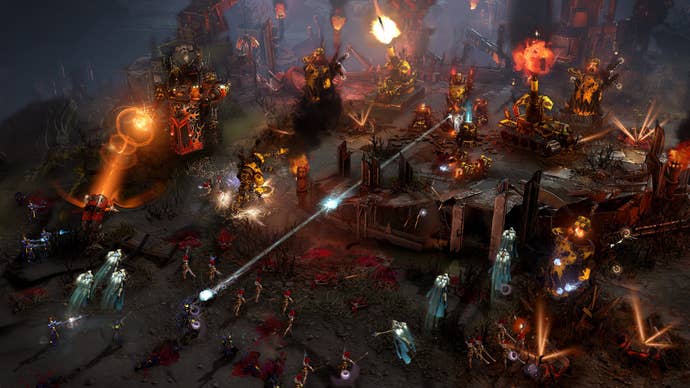
Each game has its own fanbase. Relic made them work as a franchise through, mostly through strong expansion support for each title, adding additional campaigns and races to the mix.
Dawn of War III looks to reinvent the wheel again, sitting in-between the previous two Dawn of War titles. There is base-building and resource gathering through controllable points, but the armies are smaller and summonable elite units work like the heroes in Dawn of War II. You can compare DoW III to Warcraft III or Relic's Company of Heroes. Unlike Dawn of War II's heroes, Elites stay at a mostly similar power-level, with power escalation coming through summoning better elites and the massive Super Elite units.
On top of this, Relic has added a multiplayer mode that leans towards the MOBA style of play, complete with MOBA terminology for your selected elite units. (The operative word is "leans". This is still firmly a real-time strategy title.)
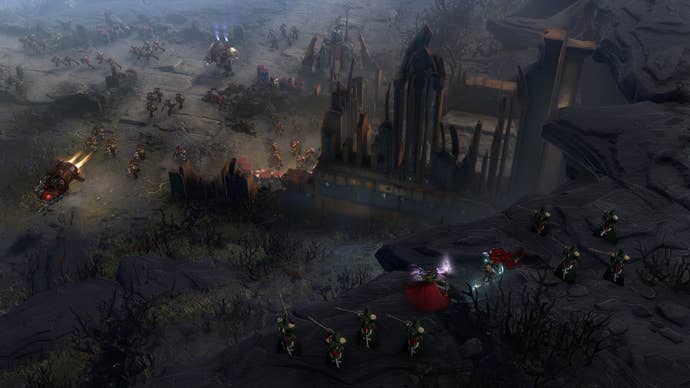
An Eternity of Carnage and Slaughter
The narrative and single-player campaign of Dawn of War III takes place on the planet Acheron, where the Space Marines, Orks, and Eldar all collide in all-out war. The planet hides a secret though, a powerful weapon that characters from each faction would love to control. The campaign has you jumping from faction-to-faction, filling in the overall mystery and giving you a feel for the basic units and Elites. For all you Dawn of War veterans, Gabriel Angelos is still out there kicking around his big hammer and Farseer Macha leads her warhost.
The story is decent, but I don't feel it necessarily stands up to Dawn of War's Dark Crusade or Dawn of War II's Chaos Rising expansion. It feels like a lengthy tutorial for the game's multiplayer mode, letting players understand the full scope of the three factions.
The Space Marines are the most straightforward faction, collecting resources to build new buildings and unlock upgrades back at their base. The kicker here is the ability to shove squads into drop pods to deploy the around the battlefield. The pods act as a one-shot artillery upon entry, so you can use them to soften an enemy line.

Orks are slower and more aggressive than the other three factions, but also the most variable in terms of composition. Ork bases are fortified and upgraded by Waaagh towers. These towers not only upgrade your overall strength they also drop Scrap at a set interval, which you can use to buff your units and gain new abilities. Gretchin workers can turn Scrap into the ork mechanized units, versus the Space Marines having to build a specialized Machine Cult building. Scrap can also be found on the battlefield by destroying mechanized units, giving Orks a mid-field push advantage. Some Elites can even store or summon Scrap.
Then there's the Eldar, which are the fastest and most subtle faction in Dawn of War 3. They're tricky, meant for hit-and-run attacks and whittling down enemy forces. All Eldar units have shields that have to be taken down before they can really be damaged. In addition, the Eldar can construct Webway Gates to get around the map quickly and their structures make every unit faster as a passive.

The Emperor's Angels of Death
On top of the basic composition of each race, you have Elites and Doctrines. Elites are the key units in your army. While basic units and structures require requisition and power to build, Elite units are summoned via elite points. Each Elite has an elite point cost, with stronger Elites and Super Elites costing 7-10 points. You earn the points slowly during any match, or through the center Elite node in multiplayer.
Elites are your heroes, each with direct attacks, special abilities, and army buffs. You'll eventually choose a set of three Elites from your unlocked group. Maybe you want a Hero to lead your army, or you may summon a Super Elite, like the Imperial Knight, to push an enemy stronghold with overwhelming firepower. Super Elites feel damned powerful, tearing up entire armies on their own when they enter the picture. You never completely lose an Elite if they happen to die, as they go on cooldown for previous minutes. Choosing which three Elites to take into a map is part of the strategic layer.
Then there's Doctrines, passive abilities that add some new capabilities to existing units. There are Elite Doctrines, like Gabriel Angelos' with the Slam Barrier, which offers a short-lived barrier to one of the Dreadnought's abilities. Then there are Army Doctrines, like the Eldar's Webway Holo-field, which offers stealth capabilities to units near your Webway Gates. You pick three of each (one per Elite, and three per Army) and they allow you to tailor each faction to what you believe you'll encounter in each match. Together Elites and Doctrines allow for gameplay customization of your armies.
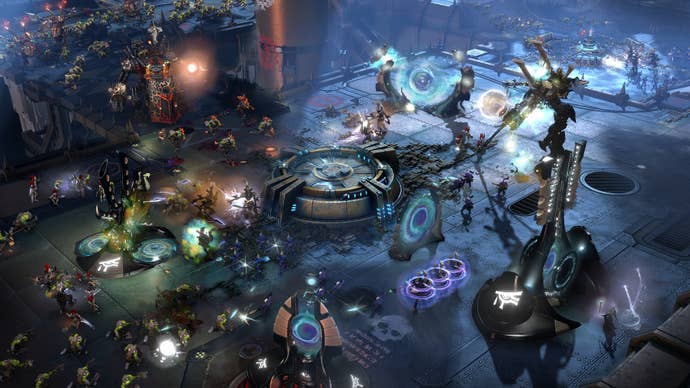
War is All We Are!
One thing that surprised me is that Dawn of War III is a much more aggressive game than its predecessors. It moves faster, requires more moment-to-moment micromanagement, and the resources being based on control points focuses combat on specific map areas. The Elites tend to focus on strong pushes into enemy territory or structures.
This carries into the game's multiplayer, which as I said, leans a little towards the MOBA genre. Whether you're in 1v1, 2v2, or 3v3, you'll be presented with a map full of uncontested points that need to be taken to gain the resources needed to build and upgrade your army. Turtling isn't really a strategy here. You can take a break to heal up and replenish your forces, but Dawn of War III wants you to be moving forward, capturing and defending nodes, and expanding your territory.
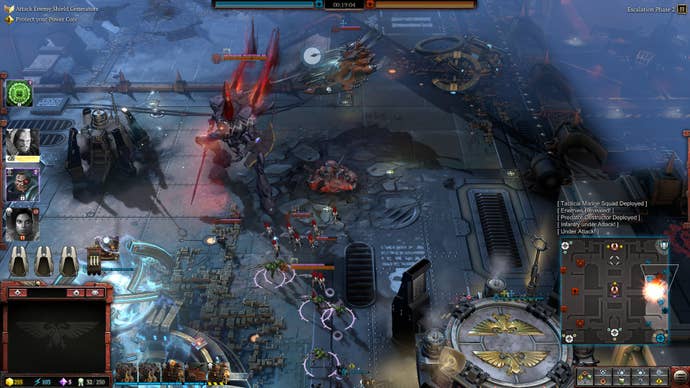
The MOBA genre began as a mod for Warcraft III, but Dawn of War III's multiplayer wonders if there's a way to bridge the gap between the two. Like a MOBA, your ultimate objective is to destroy your enemies' Core. These structures can only be damaged once you've taken down both of an enemy's shield generators. Yeah, you can mostly ignore the rest of an enemy's base if you want. There's no point victory available here, core destruction is your only objective.
So what you end up with is a fairly aggressive RTS with a singular focus. I do wish there were more victory conditions available; hopefully that's something coming in an expansion.
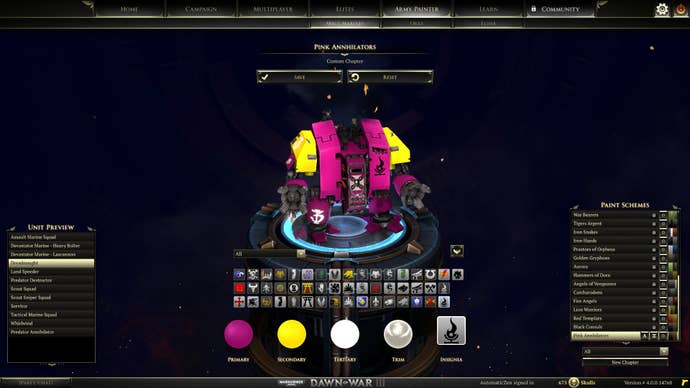
I Bear The Colors of My Chapter Boldly
Dawn of War III also has the MOBA feel in its progression system. You'll gain skulls for every match and campaign map, which you then use to unlock Elites and Doctrines. Your chosen Elites also gain experience in each match, unlocking new abilities and master skins at higher levels, just like a MOBA.
Speaking of skins, Relic has also beefed up everyone's favorite Dawn of War feature, the Army Painter. The Space Marine, Orks, and Eldar come with a host of pre-installed colors and emblems, reflecting the lore of the Warhammer 40K universe. On top of that, you can make your own Chapter, Clan, or Craftworld, choosing an emblem, primary color, secondary color, tertiary color, and trim. You have a choice of matte, glossy, or metallic paint this time around, meaning you can create your own magical combinations without having to spend hours painting miniatures.
The art style overall is fairly detailed and well-animated, but it is a bit brighter than previous games. I think that may turn off some fans of the grimdark forever war, but Dawn of War III still captures the correct feel of Warhammer 40K. Watching a Wraithknight striding across the battlefield, or an enemy army scattering underneath artillery fire is always satisfying, given some fairly detailed animations. And the environment art is top-notch, especially in the campaign.

I did run into a bunch of small bugs and errors while playing Dawn of War III. Setting up a multiplayer match with someone else was a bit of a nightmare, as I couldn't see their invite, forcing them to set the lobby to public so we could team up. I ran into a two crashes, one after the end of the multiplayer match. My sparring partner reported the game has an always-online connection, meaning that you can't do anything if you disconnect. And there were finicky UI issues that popped up from time to time.
I'm mostly onboard with Dawn of War III. Relic Entertainment is trying to hit a solid middle ground between the two previous versions of Dawn of War. Splitting the difference may in fact turn off fans of either style, but personally I think they've hit a good balance. The more aggressive combat style means short matches in multiplayer and skirmish modes, so I'm thankful for the change, given the limited time I have for non-work games these days.
Is Dawn of War III perfect? No. But neither were its predecessors prior to their excellent expansions. Relic needs to do a few passes of bug fixes, throw in some new modes, and add more of Warhammer 40K varied factions to the pot. But for now, this is still a great addition to the series and a solid base to build on.
Lasting AppealOnline multiplayer is where the game's true life lies, once you've polished off the campaign.
VisualsThis is a great-looking game, from the animations to the environmental art, even if it's not a grimdark as some would like.
ConclusionAfter the pure RTS of Dawn of War and the RPG leanings of Dawn of War II, Relic Entertainment decides to settle in the middle ground with Dawn of War III. Base-building returns, heroes get an overhaul with Elite units, and combat becomes more aggressive and faster-paced. Dawn of War III is a game that pulls from its past, while taking some elements from modern day gaming to make something new in the franchise.

